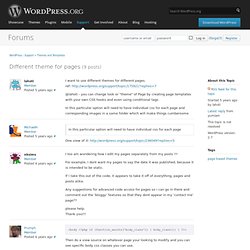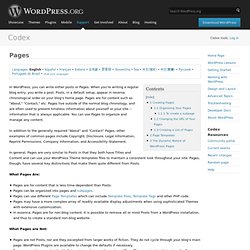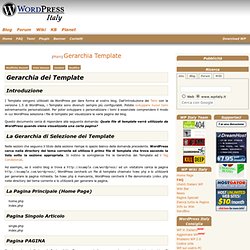

How WordPress Themes Actually Work [INFOGRAPHIC] WordPress developer and all-around web geek Joost de Valk has just graced the Internet with a highly useful infographic.
![How WordPress Themes Actually Work [INFOGRAPHIC]](http://cdn.pearltrees.com/s/pic/th/wordpress-actually-infographic-51024265)
For a medium that leans toward the amusing, infographics can occasionally be enlightening or even helpful for later reference. This one serves as a sort of "cheat sheet for how your blog works" and takes the reader through the basics of a normal WordPress theme. It's a posts-to-plugins look at the anatomy of a typical WordPress theme. Have a look, and let us know what you think in the comments. How to Create a Custom Wordpress Home Page Template. Multiple sub directories for theme template pages.
How to create custom Wordpress Page templates – for example a page showing subpages. Create a php file with some unique name (like snarfer.php) and put it in your WordPress theme directory.

This is the way you create a WordPress Page templates: <? Php /* Template Name: Snarfer */ This is an example of a Worspress Page template which displays a Page including subpages: Conditional tags for a Page templates are: is_page_template() is_page_template( ‘the_name_of_yout_page_template.php’ ) More info for conditional tags – Before you see the newly created WordPress Page template you may need to go to your theme manager and reactivate your current theme, otherwise you may not see the new Page template in the drop-down inside the administration of your pages.
Where to put snarfer.php? Support » Different theme for pages. <body <?

Php if (function_exists('body_class')) { body_class(); } ? >> Then do a view source on whatever page your looking to modify and you can see specific body css classes you can use. For example: This is my archive page, root level page for all the different archive pages I have. If I wanted to hide say the title which in my css the element is div class="pagetitle" that will make that .pagetitle on that specific page, disappear.
Notice the body classes also include if someone is logged in or not and since they are logged in I want to, I dunno make the title white /shrug With body_class you can pretty much do anything to any specific page on your site just by getting a class from the body_class that is individual for just that page. *the IE that you see in the body class was added there by an function in my functions.php* That will add the type of browser the end user is using to the body_class.. but you can also do some fun things with it as well. Pages. Pages Languages: English • Español • Français • Italiano • 日本語 • 한국어 • Slovenčina • ไทย • 中文(简体) • 中文(繁體) • Русский • Português do Brasil • (Add your language) In WordPress, you can write either posts or Pages.

When you're writing a regular blog entry, you write a post. Posts, in a default setup, appear in reverse chronological order on your blog's home page. Pages are for content such as "About," "Contact," etc. In addition to the generally required "About" and "Contact" Pages, other examples of common pages include Copyright, Disclosure, Legal Information, Reprint Permissions, Company Information, and Accessibility Statement.
In general, Pages are very similar to Posts in that they both have Titles and Content and can use your WordPress Theme templates files to maintain a consistent look throughout your site. What Pages Are: Pages are for content that is less time-dependent than Posts. What Pages are Not: Pages are not Posts, nor are they excerpted from larger works of fiction.
Custom Post Type Creator. Custom Post Type UI. Custom Post Template. Utilizzare Pagine. 1. Introduzione Le Pagine sono simili agli articoli con la differenza che "vivono" all'esterno della normale cronologia del blog. Potete utilizzare le Pagine per organizzare e gestire qualsiasi quantità di contenuti. Ma come funzionano le Pagine in WordPress? Lo scopo di questo documento è di provare a descrivere cos'è una Pagina e cosa non è, descrivere cosa può fare una Pagina e fornire alcuni esempi. 2. La parola "pagina" è sempre stata utilizza per descrivere qualsiasi documento web in HTML . Per altri dettagli relativi alla nomenclatura di Pagina si veda Una nota sulla Nomenclatura . 3. Gli Articoli sono oggetti che fanno riferimento al tempo. Ovviamente questo è il vostro WordPress; potete farci quello che volete.
Alcuni esempi di Pagine che potete creare sul vostro sito includono: Copyright Informazioni Legali Permessi di Ripubbicazione Informazioni sui Contatti Chi sono Questo Sito. Sviluppare Temi. 1. Utilizzare i Temi Se foste interessati ad imparare su come installare ed utilizzare i temi si veda la documentazione relativa all' Utilizzo dei Temi . 2. Introduzione Si può voler sviluppare dei temi WordPress per il proprio utilizzo o per distribuirli. Gerarchia Template. Introduzione I Template vengono utilizzati da WordPress per dare forma al vostro blog.

Dall'introduzione dei Temi con la versione 1.5 di WordPress, i Template sono divenuti sempre più configurabili. Potete sviluppare nuovi temi estremamente personalizzabili. Tabella colori interattiva con nomi in italiano e codice RGB. Child Theme: modificare temi WordPress in modo intelligente. Online Color Scheme Generator. Color Scheme Designer 3.